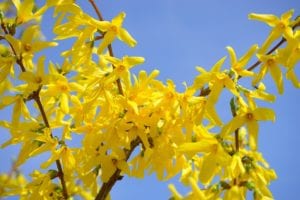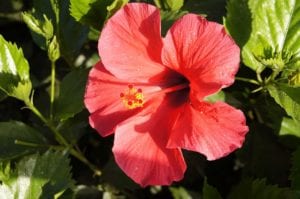Today, the range of garden plants is growing every year. These bushes and trees are designed to decorate our earth plots. Constantly there are new varieties, and old, already familiar, get new sizes, colors and shapes. Understand what is a classic, and that just a trend of fashion is quite difficult. That is why we should talk about the most popular ornamental garden plants. It should be noted that they are in demand also because they are quite easy to take care of.
Spiraea
Image credit: Johan1127
Spirea are quite hardy plants. They know many varieties. Those that blossom in the spring have white flowers, and those who chose the summer have purple-red or pink flowers. In height, plants usually reach from 1 to 2.5 meters, within the same range the diameter varies. To plant spiroea better or in the sun, or in a semi-shadowed place. But the soil in the garden for this any. Those species that blossom in the spring are cut shortly after the flowering period. Summer species are treated in early spring. Advantages of this plant are obvious – it is very unpretentious, even a beginning gardener will cope with it. Also worth noting is the relative compactness of the spiraea, some of its stunted species (for example, Japanese) in height barely reach 80 centimeters. Disadvantages of the flowering in spring species is the need for their timely pruning, otherwise the intensity of flowering will be low.
Acer platanoides.
Image credit: thomashendele
Particular attention should be paid to the grade “Globosum”. This kind of maple looks like a massive tree, although its dimensions are rather modest. A spherical crown will look great on small areas and front gardens. Acer platanoides height reaches 6 meters, and the diameter of the crown can reach 5-6 meters. This tree also loves light, so it does not need a shadow. And the maple does not put special demands on soil, any place in the garden will do. Trimming maple is also not particularly needed, occasionally you can cut branches along the width of the crown. Among the advantages of such a plant is its dense crown, which creates a dense shadow. In autumn the leaves of the acer platanoides are painted in bright yellow color. However, for such beauty you have to pay – in the autumn of foliage will be quite a lot, and because of the lack of pruning the crown may over the years grow in breadth.
Forsythia.
Image credit: Hans
This plant is a symbol of the onset of spring, one of the most beautiful in this case. Golden-yellow bush flowers look beautiful next to the blue and blue primrose. Forsythia can reach a height of up to 3 meters, so is its diameter. This plant is best planted in a sunny place, there are no special requirements to the soil of the garden. After flowering, forcing should be cut off. This plant is rather unpretentious, which will be appreciated by beginning gardeners. In addition, the variety of varieties will allow you to choose the best. For example, for small plots low-grade varieties will do. Week End has a height of only 1 meter. Cut branches are often put in a vase, the flowers will dissolve much later. It will be amazing to see a blossoming plant for Christmas and New Year at home. However, after blossoming, the shrub quickly loses its decorative appearance. Yes, and cut the forcing is necessary regularly, otherwise the flowering will begin to lose in intensity.
Hibiscus syriacus.
Image credit: SylwiaAptacy
This shrub looks great, both in solitary planting, and in a group of brethren, as well as in a hedgerow. Hibiscus in southern regions can grow even in the open ground. The height of the shrub is from 1.5 to 2 meters, its diameter is from 1 to 1.5 meters. It is best to plant hibiscus in a sunny place, while the soil must be fertile and water-permeable. Pruning plants is carried out in February – early March. A garden plant is valued for variety of varieties and a large range of color colors. He is afraid of the hibiscus of colds, which can be attributed to his shortcomings. Even a cool summer leads to less abundant flowering.
Laburnum.
Image credit: markus53
Laburnum. Another name for this plant is “Golden Rain”. It appeared because when the bushy tree blossoms in May-June, its long floral brushes resemble streams of rainwater. Bobovnik excellent will look, both independently and next to other cultures. In height, the bright plant reaches 7 meters, and its diameter – up to 4 meters. The lover loves the sun, and in terms of soil unpretentious. Even crop this garden plant is not required. Advantages of the beaver are its unpretentiousness and easy maintenance. Beautiful are not only flowers, but also leaves. However, there are bugs and its drawbacks – the plant is considered poisonous, especially harmful substances in the seeds. So you should be careful if children live near the landing site. Branches of the plant are quite fragile and can break even from the severity of the snow.
Catalpa.
Image credit: dmgreen44
This heat-loving plant on our expanses looks especially exotic and decorative, thanks to its large leaves are heart-shaped. And at the beginning of the summer the catalpa blooms, showing numerous flowers-bells. In height, the tree reaches 10-15 meters, and its diameter – 6-10 meters. For landing is best suited solar place, protected from the wind. To the soil of the garden there are no special requirements, even from pruning is better to refuse. For small plots or front gardens, it is better to choose “Nana”. The height of the tree will then be no more than 7 meters, and the crown of the plant will be spherical.
Weigelia
Image credit: shell_ghostcage
Best of all, these unpretentious shrubs will look like hedges. Particularly beautiful if you make them from several ornately flowering shrubs. Weigel looks good in the company with a lilac or kolkvitsey. The time of flowering of the plant depends on the variety, some are dissolved in May-June, and others – from June to August. The height and diameter of the shrub does not exceed 3 meters. It is best to plant plants in a sunny place or with scattered lighting, while the soil will fit in any garden. Crop the wiggel after flowering. Advantages of the plant are its unpretentiousness, which is especially convenient for beginning gardeners. The Purpurea variety is popular, which does not reach a height of one and a half meters. But the disadvantages of the plant is that they have to be cut every year. Otherwise, the bloom will be weakened.
Decorative apple tree (Malus).
Image credit: Hans
These apple trees please not so much fruits, as their flowers. Almost all of them are similar in appearance not so much to small trees, but generally to shrubs. There are many varieties of ornamental apples, which differ in the form of their growth, coloring of flowers. When the flowering season begins in May, the branches literally sink in a sea of white, pink or red flowers. Such apple trees can reach a height of 2 to 10 meters, and the diameter of their crowns to 8 meters. Trees like sunny places, they need the soil friable and fertile. Apple trees need to lighten the crown and remove wildlife. In summer and autumn, it is time to harvest. Beautiful fruit is perfect for making dessert. However, there was a decorative apple tree and no shortcomings. It is often affected by diseases – powdery mildew and scab. That is why, even at the time of purchasing a seedling, you should be careful, it is better to do it in a checked and reliable place.
Rhododendron
Image credit: congerdesign
This garden plant has many varieties. In addition to the rhododendron itself, generic varieties are also isolated, for example, smaller azaleas. In height, shrubs can reach from 1 to 5 meters, about the same as their diameter. Rhododendron does not like the sun, so it is better for him to find a place in the shade. The plant prefers acidic soil, fertile and water-permeable. Crop the bushes is not necessary, although in extreme cases, radical pruning is allowed. The advantage of this plant is that most species are evergreen. Deficiencies lie in special requirements to the soil, susceptibility to diseases, as well as the need to constantly water the rhododendron in an arid period.
Hydrangea.
Image credit: A_Knop
Such dwarf shrubs bloom in the summer. In height, as well as the diameter of the plant from 1 to 3 meters. Plant hydrangeas better in places with scattered light, however, neither the shadow nor the sun will prevent its growth. Soil is better to choose sour, keep it constantly slightly moist. It is recommended to cut the hydrangea in spring or autumn. To the merits of the plant can be attributed a good tolerance of even containers, and thanks to such bushes even shaded places in the garden can become more beautiful. But caring for them requires attention. For example, alkaline soil will cause the blue inflorescence to turn pink. And in dry weather do not forget about watering.
Decorative cherry, plum (Prunus)
Image credit: Kapa65
Prunus. This is a fairly large family, which includes many varieties with different characteristics. For example, in Japan plums and ornamental cherries are characterized by a long and powerful flowering. In April-May the crown of these beautiful plants is wrapped in real foam from double pink or simple flowers. In height, the trees grow 2-12 meters, their diameter is 2-10 meters. This species loves a rich and fertile soil with good water permeability. But pruning cherries and plums is better not to produce. Advantages of this ornamental plant are that it is possible to choose their shape practically for a garden of any kind. It can be columnar, tiered or crying. The disadvantages lie in the fact that in slow growing varieties, the tips of shoots may die prematurely.














